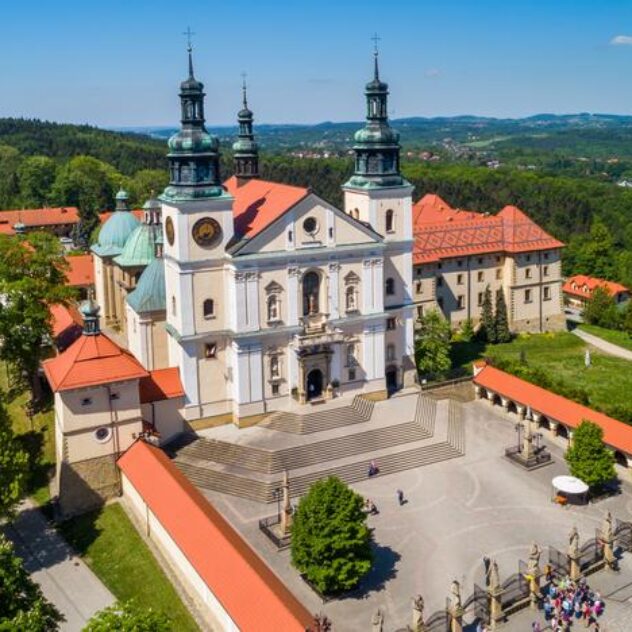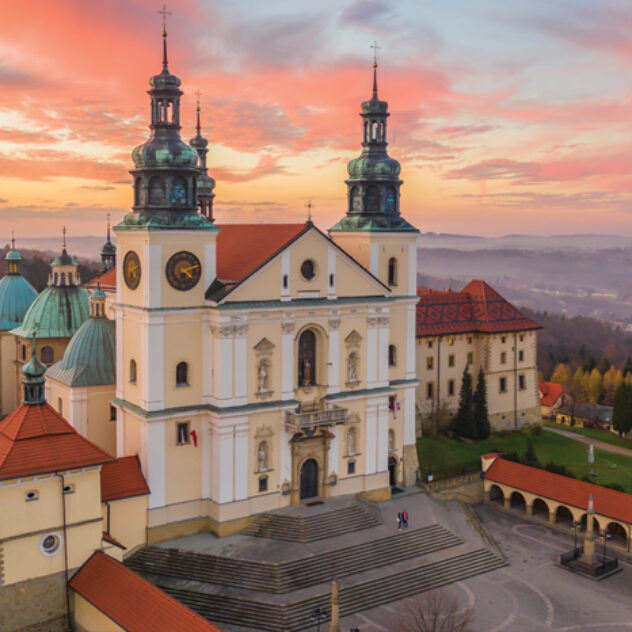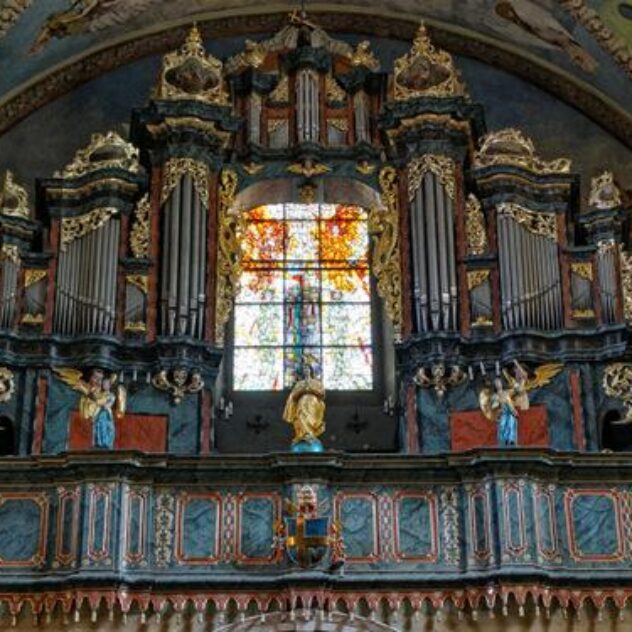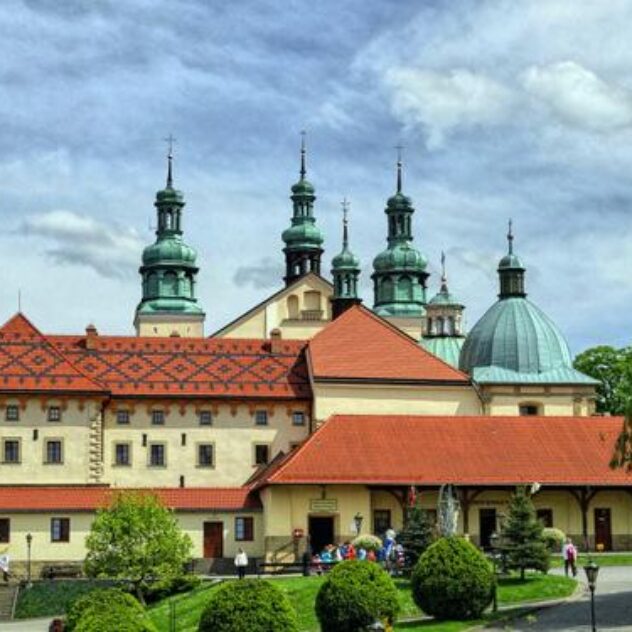The Passion and Marian Sanctuary in Kalwaria Zebrzydowska
Information about the pilgrimage site
The Passion and Marian Sanctuary in Kalwaria Zebrzydowska is one of the most important places of the Passion and Marian cult in Poland. Picturesquely situated above the town, it is not only a church and monastery, but also a complex of chapels and a landscape park.
More than 1.5 million pilgrims visit this unique religious and cultural site every year. And it all started at the beginning of the 17th century. According to legend, Mikołaj Zebrzydowski, the governor of Cracow, one day saw the embers of three burning crosses rising towards the sky on a hill. On this spot, in 1602, he founded a church and gave it into the care of the Bernardine Order. Over time, thanks to the Zebrzydowski family, the complex began to grow. A Baroque church was built, housing the miraculous image of Our Lady of Kalwaria, followed by the Bernardine monastery. Both buildings were designed by the architect Giovanni Maria Bernardoni and the Flemish architect and goldsmith Paul Baudarth. He also designed almost all of the chapels on Calvary’s Way of the Cross, known as the Calvary Paths (the Lord Jesus’ Paths, arranged in a narrative sequence, tell the story of Christ’s Passion. They include, among others, the chapels of the Cenacle, the Gethsemane, the Apprehension, the House of Annas and Caiaphas, Herod’s Palace and Pilate’s Town Hall. Some stations of the mystery are marked by small architectural forms, such as the chapel of St Veronica. The culmination of the Passion Roads with the chapels of the Crucifixion, the Deposition from the Cross and the Lord’s Tomb is on Mount Zar; the Paths of the Virgin Mary are used to contemplate Mary’s pain under the Cross, e.g. the Chapel of the Heart of Mary, Jesus’ burial and triumph after the Resurrection. Some buildings located where the two routes converge, such as the Church of the Holy Sepulchre of Our Lady, are common to the Marian and Passion sections. The entire site also includes buildings that do not belong to both cycles, e.g. Bethsaida, the Hermitage of St Mary Magdalene. The individual sites in the topography correspond to the names of places in Jerusalem (Golgotha, Zion, Mount of Olives)). And also the hermitage of the Five Polish Brothers and the chapel of Saint Mary Magdalene. The model for their construction was the Way of the Cross of the Lord Jesus in Jerusalem.
The Baroque basilica houses the venerated miraculous painting of Our Lady of Kalwaria, which was donated to the sanctuary in 1641. During Holy Week, the Passion plays out here, culminating on Good Friday, drawing thousands of pilgrims to the sanctuary in Kalwaria Zebrzydowska.
In 1979, Saint John Paul II visited the sanctuary, elevating it to the rank of basilica minor. The Pope visited here while he was still a layman, and then as Bishop of Krakow. This one of the most important Polish sanctuaries was inscribed on the UNESCO World Cultural and Natural Heritage List in 1999. For more information https://whc.unesco.org/en/list/905/.
Tourist attractions in the vicinity
Lanckorona – is considered to be the most charming village in Poland, described as the “City of Angels”. It is situated on the Amber Trail. The most atmospheric place and at the same time the village’s showpiece is the Lanckorona Market Square. The unusual shape of the terrain (sloping, with a gradient of almost 10 per cent), the cobbled streets and the surrounding wooden cottages from the 19th century make a walk through Lanckorona’s marketplace transport visitors back in time. The characteristic buildings with arcaded houses around the square make it one of the prettiest old wooden building complexes in Poland. Neat one-storey houses are covered with shingles, enriched with porches with lattice balustrades and covered with arcades, under which merchants used to display their goods. The wooden buildings of Lanckorona have been included on the Wooden Architecture Route.
Among the best preserved buildings are those located on the eastern frontage of the market square and on the neighbouring streets: Świętokrzyska, Zamkowa, Krakowska and Piłsudskiego Streets. It is not without reason that the Lanckorona market square is often referred to as a “living open-air museum”. Family life goes on in the houses, and there are often mysterious, beautiful gardens hidden from view from the street.
Lanckorona has no shortage of cosy cafés and restaurants bustling with life, especially in spring and summer. The network of winding streets is lined with souvenir and handicraft shops, cafés and galleries. One of the most atmospheric cafés and restaurants is the “Arka”. Arranged in a historical cottage, it also tempts with its beautiful garden. While there, it is worth visiting the Regional Museum, the parish church of St. John the Baptist founded by King Casimir the Great and the ruins of the Gothic castle. More details https://visitmalopolska.pl/-/lanckorona-miejsce-aniolow-i-zakochanych.
Basilica of the Presentation of the Blessed Virgin Mary, Wadowice – in this church Karol Wojtyla was baptised and later received his First Holy Communion and Confirmation. During his pilgrimages to Wadowice, the Pope visited his parish church three times. In 1999, he crowned the image of Our Lady of Perpetual Help. On 15 May 2011. the then Metropolitan of Krakow, Cardinal Stanisław Dziwisz handed over the relics: the blood of John Paul II in a special reliquary – a golden monstrance with the coat of arms of the former Pope, which are kept in a special papal chapel. More details https://www.wadowicejp2.pl/.
John Paul II Family House Museum, Wadowice – a house at 7 Kościelna Street, where Karol Józef Wojtyła was born on 18 May 1920 at around 5 pm. The future Pope spent his childhood and youth there. Between 1919 and 1938, the Wojtyła family occupied two rooms with a kitchen on the first floor. In 1984, a papal exhibition was opened to the public. In 2010, a major renovation of the building began, resulting in the adaptation not only of the Wojtyła flat, but of the entire building for the museum. After opening in 2014, tourists can, thanks to a multimedia exhibition spread over more than 1,000 m2 of space, learn about the entire life journey of St John Paul II. At the heart of the museum is the Wojtylows’ flat, where Karol was born and lived for 18 years. Inside there are original exhibits related to the Wojtyła family. The Family Home Museum of the Holy Father John Paul II is a cultural institution created by: Minister of Culture and National Heritage, Małopolska Voivodeship, the Municipality of Wadowice and the Archdiocese of Kraków. More details: https://domjp2.pl/.
Monastery of the Discalced Carmelite Fathers – the beginnings of the Wadowice Discalced Carmelite Monastery are linked to the person of St Rafał Kalinowski. This military engineer, participant in the January Uprising, joined the Carmel after returning from exile. Arriving in Wadowice in 1892, he founded the monastery. Today it comprises a church, a monastery and a retreat house.
Karol Wojtyla had strong ties with the local Carmelite monastery, as he received his first scapular here. As he recalled, he had met the Carmelites since he was a child and was familiar with their distinctive habit. He often went with his father to St Joseph’s Church, where he received spiritual formation, benefited from the sacrament of penance and participated in devotions. He received his first scapular after his first Holy Communion, becoming a member of the Confraternity of the Holy Scapular at the same time. From then on, also as Pope, he always wore a linen scapular and never replaced it with a scapular medallion.
After the death of John Paul II, the Carmelites of Wadowice asked Cardinal Stanislaw Dziwisz to donate the papal scapular to the monastery. Today, this relic is displayed in a golden rosette placed on the wall to the left of the altar of Our Lady of the Scapular. In 2004, the image of St Joseph in the main altar was adorned with a special votive offering – the Fisherman’s Ring of the Holy Father John Paul II – and the Church of the Discalced Carmelites “on the Hill” was given the title of St Joseph’s Sanctuary. More details: https://karmel-wadowice.pl/
The Park of Miniatures in Inwałd – is a magical place with 65 famous buildings from all over the world. Visiting this place, one can visit Poland from the Tatra Mountains themselves, through Kraków, Warsaw, to the Baltic coast. In one day, you can stand under the Eiffel Tower, take a photo under St Peter’s Basilica and find out what time Big Ben is pointing at. Most of the miniatures in the Miniature Park are made at a scale of 1:25, the Vatican complex – St Peter’s Square and St Peter’s Basilica – at a scale of 1:15, and the Venetian complex – St Mark’s Square, St Mark’s Basilica, St Mark’s Bell Tower – at a scale of 1:10. More details https://parkswiatmarzen.pl/.
Other tourist attractions near the pilgrimage site can be found on the website of the Malopolska Tourist Information System: https://visitmalopolska.pl/.
Accommodation
– Accommodation for pilgrims Pilgrim House (http://dompielgrzyma.kalwaria.eu/ ).
– Other accommodation in Kalwaria Zebrzydowska or surrounding towns.
Availability
By car
Getting there by car is the fastest way. Kalwaria can be reached from Krakow, Wadowice or other towns in Lesser Poland, as well as from many cities in Poland. From Krakow, the distance is about 40 km. When you arrive in Kalwaria Zebrzydowska, follow the road leading to the Sanctuary itself. Car parks are located in the vicinity of the Sanctuary; the distance to be covered on foot depends on the specific location of the car park.
By public transport
You can get to Kalwaria by train and bus, for example from Krakow, Wadowice or Bielsko-Biała. Once you arrive at the train station, you can either take a taxi or walk to the Sanctuary. It takes about 3 km to walk from the railway station and about 2 km from the bus station.
On foot
The pilgrimage site can be reached on foot via designated trails.
On a bicycle
For more active travellers, it is possible to cycle to Kalwaria Zebrzydowska. There are cycle paths leading to the region, and once you arrive in Kalwaria, you can leave your bike in the car park and complete the journey on foot.








